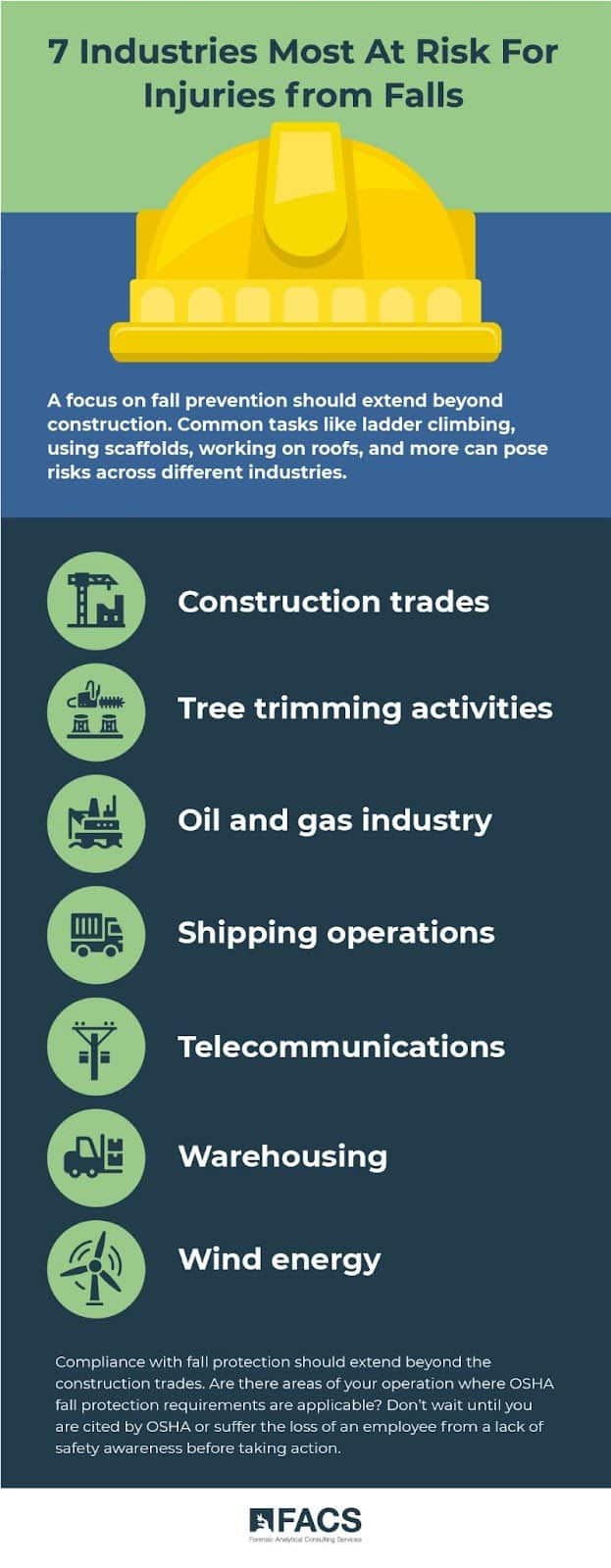The same OSHA safety violation has topped the list for the last 13 years. In 2023, OSHA citations for that violation (fall protection) more than doubled the number of citations issued for the second-ranked safety concern (hazard communication).
Assessing your workplace or worksite risk profile and taking steps to ensure your workers comply with OSHA regulations can go a long way toward protecting both your company and your workers.
In this article, we’ll look at fall protection since it is by far the first on the OSHA violation list and the steps employers can take to lessen the likelihood of accidents and safety violations.
Here’s something to note: The procedures below are focused on fall protection, however, they can be applied across the range of threats to safety your company and team may face.
How OSHA Defines “Fall Protection”
The first thing to note on OSHA’s list of top 10 citations in 2023 is that fall protection not only ranks number one on the list, but it also ranks number eight!
How can that be?
OSHA considers fall protection “general requirements” as separate from fall protection “training requirements.” That means having the required protections in place isn’t sufficient. Employees must not only be protected from falls; they must also be properly trained on how to identify issues and properly use equipment.
Here is how OSHA defines fall protection: “Fall protection means any equipment, device, or system that prevents an employee from falling from an elevation or mitigates the effect of such a fall.”

Which Industries Are Most At Risk for Injuries Due to Falls?
Construction workers can face fall hazards in many of the tasks assigned. Ladder climbing is always a concern, but using scaffolds, working on roofs, and other common tasks also pose risks.
Industries where fall protection is especially critical include the following:
- Construction trades
- Tree trimming activities
- Oil and gas industry
- Shipping operations
- Telecommunications
- Warehousing
- Wind energy
Fall protection concerns aren’t limited to the construction trades. Consider your own company. Are there areas of operation where OSHA fall protection requirements may be applicable? If so, take action. Don’t wait until you are cited by OSHA or, worse yet, suffer the loss or impairment of an employee from a lack of safety awareness and compliance.
How Can Employers Comply with OSHA Regulations?
Fall protection could seem to be one of the simplest of all safety regulations to observe. So why is it on top of the violation list?
From training to application, fall protection measures can get complex. Here are the basic components:
- Employers must know which methods and equipment are required by OSHA regulations for fall protection in the work they perform.
- Employers must install and maintain the equipment properly and consistently.
- Employees must receive required training before using the equipment and must be educated on fall protection risks.
- Employees must enact the required safety measures according to the conditions and in the manner required by OSHA.
Those four steps may seem simple, but compliance isn’t always easy. The OSHA top 10 violations list proves that.
Here are examples of issues FACS environmental health and safety experts commonly see contributing to the problem:
- Compliance with OSHA fall protection standards requires more than a one-time expense and effort. Make sure you understand exactly what you need to do, when it needs to be done, and who must do it to stay in compliance.
- Don’t try to cut corners with your safety efforts. One accident can quickly overrun any savings from trying to sidestep regulations. Get the proper equipment, maintain it according to regulations, provide the proper training, and check to confirm employees are consistently observing safe working procedures.
- Don’t forget about refresher training and training for new employees.
- See your safety program as an ongoing, evolving activity — never as a one and done chore. Employers must stay updated on OSHA regulations and industry best practices for fall protection. Safety equipment technology, safety regulations, and recommended methods are subject to change.
- FACS safety audits often spotlight issues the employer didn’t see. Make sure you conduct safety audits regularly to identify potential hazards and ensure compliance with OSHA standards.
- Company culture is a primary part of safety on the job. Employees who clearly and regularly see management’s concern about their safety are more apt to stay employed with the company. Your obvious concern for the health of your employees can prompt the development of their own desire to observe safe working practices.
Here’s another tip from FACS environmental health and safety fieldworkers:
Involving your employees in safety discussions and planning can not only lead to more practical and effective safety measures but can help you create a “culture of safety” for your company.
To get help with developing your safety program, auditing your safety program, and making sure you are on track with OSHA requirements, call FACS to get assistance from our health and safety specialists.
Your investment in safety can help protect your employees, prevent fines from OSHA or other regulatory agencies, and increase your company’s ability to hire and keep quality employees — employees who care about safety.
Call FACS at (888) 711-9998 for additional information, or submit your information through our contact form and we’ll be in touch with you shortly.